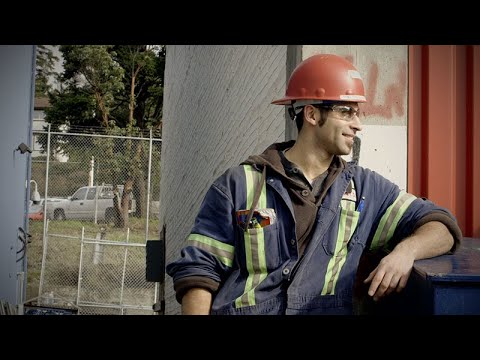Career Overview
Steamfitters/pipefitters design, assemble, install, maintain, troubleshoot and repair pipes carrying water, steam, chemicals and fuel in heating, cooling, lubricating and other process piping systems. Steamfitting/pipefitting is a trade that specializes in high-pressure liquid, gas piping and other systems.
Sprinkler system installers design, assemble, install, maintain and repair water, foam, carbon dioxide and dry chemical sprinkler systems in buildings to protect homes, offices, warehouses and other structures from fire.
Job Titles
Duties
Steamfitters/pipefitters:
- Read and understand drawings, blue prints and specifications to plan their work
- Identify how and where to cut openings for pipes in walls, floors and ceilings using power tools or machines
- Select the type and size of pipe needed and measure, cut, thread and bend into the right shape
- Work with and support the welder at certain stages of the project
- Braze, solder and thread joints to:
- Join pipes and make sections of piping system
- Install supports, valves, piping and control systems
- Test new and existing piping systems for leaks and make sure the system is working
- Clean and maintain pipe units and fittings, remove and replace worn components, as well as flush and reactivate systems
- May work with field engineers and clients to plan projects
Sprinkler system installers:
- Read and understand drawings, specifications and fire codes to determine layout requirements
- Install clamps, brackets and hangers to support sprinkler equipment using hand and power tools
- Select, measure, cut, ream and thread pipe, install sprinkler heads and mount prepared pipe in supports
- Join pipes and piping sections using threaded and grooved piping equipment
- Connect finished piping systems to water mains, supply tanks, pumps, compressors and control equipment
- Install valves, alarms, controls and associated equipment
- Service and repair sprinkler systems, and test systems for leaks using air or liquid pressure equipment
- May work with field engineers and clients to plan projects
Earnings
Earnings is income that workers receive in exchange for their labour. Depending on the type of employment, earnings can be in the form of wages (hourly), salaries (fixed monthly or annual) or self-employed earnings.
Work Environment
# Workers Employed
2,305% Employed Full Time
56%People in these careers may work in the maintenance departments of large factories, manufacturing plants, hospitals, commercial buildings or other companies. They could be employed by pipeline construction contractors, thermal or steam generating plants, utility companies, oil refineries, pulp mills and gas and chemical plants. They may also work on the construction of new homes and apartment/condo buildings. Some choose to be self-employed.
Steamfitters/pipefitters often work more than 40 hours a week to meet project deadlines. Some may work out of town and temporarily relocate to remote locations for specific projects. During these projects, individuals may work for several weeks straight and then have one or two weeks off.
Sprinkler system installers typically work 40 hours a week, but overtime may be required.
Those working at factories and plants may be required to work nights and weekends or work shifts.
Work takes place indoors and outdoors. Outdoor work environments may be noisy and dirty. Workers may be exposed to extreme temperatures, depending on the season. Steamfitters/pipefitters and sprinkler system installers often work at heights from scaffolds, ladders and platforms. They may need to carry heavy items. Work may also be done in cramped and awkward spaces.
Safety measures are in place at every job site to avoid injury from falls, cuts and burns from hot pipes or equipment. People in these jobs also deal with liquids and gases under high pressure and all risks and hazards must be minimized.
Career Pathways
With experience and additional training, steamfitters/pipefitters and sprinkler system installers can move into supervisory and management positions. If they continue their education and take budgeting and business courses, they will be in a good position to advance. Some may choose to be self-employed and start their own businesses.
Occupational Interests
It’s important to understand what kinds of occupations align with your interests.
For more about occupational interests visit Skills for the Future Workforce > Characteristics.
Here are the top occupational interest(s) for this career profile:
Education, Training and Skills
Steamfitters/pipefitters and sprinkler system installers are usually required to complete secondary school.
Although certification was not required to work as a steamfitter/pipefitter in the past, many workers in these roles are certified. Those who wish to be certified must complete a four-year apprenticeship program. The B.C. government is introducing skilled trades certification beginning with a total of 10 trades, including steamfitters/pipefitters. Certification will be implemented in phases between 2022 and 2024. Learn more about skilled trades certification.
Apprenticeship programs
Work experience and in-class instruction are part of apprenticeship programs. Some part-time and online programs may be available. To apprentice, workers must be sponsored by an employer. A person who successfully completes an apprenticeship program and the final certification exam earns a Certificate of Qualification. Workers with significant experience in the trade may be able to challenge the certification exam to earn the Certificate of Qualification without completing a formal apprenticeship. For more information on earning a Certificate of Qualification, visit SkilledTradesBC.
To work in other provinces
Steamfitters/pipefitters may need Red Seal certification to work in other provinces. This can be earned by passing an exam and proving significant work experience.
Workers coming to B.C.
Steamfitters/pipefitters who are certified by a regulator elsewhere in Canada can apply for the same certification from the regulator in B.C. Under the terms of the Canadian Free Trade Agreement (CFTA), most applicants who are transferring their credentials from elsewhere in Canada will not be required to complete additional training or testing. However, the B.C. regulator may ask applicants to provide further information, such as a letter of good standing, references or a criminal record check.
Workers who trained outside of Canada
Steamfitters/pipefitters who trained outside of Canada and have never received certification from a Canadian jurisdiction will likely need a full assessment. Most occupational regulators have a process for assessment and recognize internationally trained applicants. Contact SkilledTradesBC for details on how to apply for certification in B.C.
For information about labour mobility in Canada, visit www.workersmobility.ca.
View a list of Professional Regulatory Authorities in B.C.
Education programs in B.C.

Top Skills
Every job calls for a certain set of skills. Knowing those skills is the first step in finding a good career fit.
Here, you will find the 10 most relevant workplace skills. Some are more important to achieving success in a certain career than others. These skills may come naturally to you or you may need to gain them through education, training and experience.
See the list of work-related skills below, ranked in order of importance for this career. Check out the list and see if this career matches your skills—take that first step!
Installing equipment, machines, wiring, or programs to meet specifications.
Using logic and reasoning to identify the strengths and weaknesses of alternative solutions, conclusions or approaches to problems.
Determining causes of operating errors and deciding what to do about it.
Keeping track of and assessing your performance, other individuals, or organizations to make improvements or take corrective action.
Considering the relative costs and benefits of potential actions to choose the most appropriate one.
Understanding written sentences and paragraphs in work-related documents.
Watching gauges, dials or other indicators to make sure that a machine is working properly.
Talking to others to share information effectively.
Conducting tests and inspections of products, services or processes to evaluate quality or performance.
Repairing machines or systems using the needed tools.
Labour Market Statistics
Discover data, facts and information that have been gathered and analyzed. Learn about the characteristics of the economy and labour market in B.C.
Employment
Find out about employment types and trends by region and industry.
Employment
2,305Employment by Region







| Region | Employment | % Employment of this Occupation |
|---|---|---|
| Cariboo | 110 | 4.8% |
| Kootenay | 165 | 7.2% |
| Mainland/Southwest | 1,165 | 50.5% |
| North Coast and Nechako | 35 | 1.5% |
| Northeast | 115 | 5.0% |
| Thompson-Okanagan | 270 | 11.7% |
| Vancouver Island/Coast | 450 | 19.5% |
Labour Market Outlook
The B.C. Labour Market Outlook is a 10-year forecast of the expected supply and demand for labour in the province. It’s usually updated every year. The purpose is to provide British Columbians with the knowledge to make informed decisions on careers, skills training, education and hiring.
Forecasted Job Openings (2025-2035)
900Forecasted Job Openings
Forecasted Employment Growth Rate
Composition of Job Openings
Job Openings by Region (2025-2035)







| Region | Job Openings | Avg. Annual Employment Growth |
|---|---|---|
| Cariboo | 20 | 0.3% |
| Kootenay | 50 | -0.2% |
| Mainland/Southwest | 490 | 1.6% |
| North Coast and Nechako | 10 | 0.2% |
| Northeast | 30 | 0.6% |
| Thompson-Okanagan | 130 | 1.3% |
| Vancouver Island/Coast | 180 | 0.8% |
Industry Highlights
Learn about the opportunities in B.C.'s major industries, including employment trends, earning potential, locations of work and more.
Forecasted Job Openings by Industry
| Industry | Job Openings (2025-2035) |
|---|---|
| Construction | 600 |
| Manufacturing | 120 |
| Mining and Oil and Gas Extraction | 80 |
| Repair, Personal and Non-Profit Services | 40 |
| Utilities | 20 |
Insights from Industry
The demand for steamfitters/pipefitters and sprinkler system installers in B.C. is driven largely by the construction industry. About one-half of openings result from new job growth. This industry has experienced rapid growth in its commercial and industrial sectors, creating a demand for skilled workers.
In northern B.C., many steamfitters/pipefitters work in resource-based industries, such as oil and gas, forestry and mining.
The demand for qualified sprinkler system installers has increased in recent years because building code requirements have become more extensive.
While steamfitters/pipefitters and sprinkler system installers do not weld as a part of their job, understanding welding skills is an asset to this work. They work closely and regularly with welders.
Education in math and science is important in this industry. This knowledge provides a foundation for detailed calculations that are required in planning and doing the tasks required.
Resources
-
BC Building Tradeswww.bcbuildingtrades.org
-
British Columbia Construction Association (BCCA)www.bccassn.com
-
BuildForce Canadawww.buildforce.ca/en
-
Canadian Home Builders’ Association of British Columbia (CHBA BC)chbabc.org
-
Independent Contractors and Businesses Association (ICBA) of British Columbiawww.icba.bc.ca
-
Mechanical Contractors Association of Canada (MCAC)www.mcac.ca
-
Mining Association of British Columbia (MABC)www.mining.bc.ca
-
Pipe Line Contractors Association of Canada (PLCAC)www.pipeline.ca
-
Skilled Trades Employment Program (STEP)www.stepbc.ca
-
SkilledTradesBCskilledtradesbc.ca/
-
Trades Training BC – Jobs Boardjobs.tradestrainingbc.ca/
-
UA Piping Industry College of BCuapicbc.ca
-
United Association Local 324 Victoriawww.ualocal324.com
-
United Association of Journeymen and Apprentices of the Plumbing & Pipefitting Industry of the US and Canada, Local 170ualocal170.com
-
United Association: Union of Plumbers, Fitters, Welders, & Service Techs (UA)www.ua.org
-
Vancouver Regional Construction Association (VRCA)vrca.ca
-
WorkBC Trades Trainingwww.workbc.ca/trades








